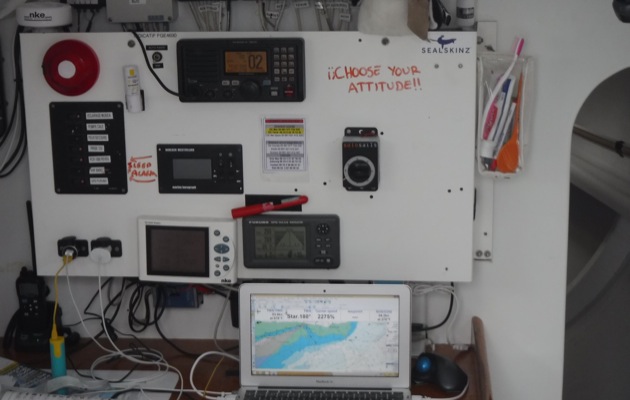We sailed with UK solo sailor Alan Roberts at Cowes Week 2015, where we were able to glean some valuable advice for the growing fleet of sailors that are taking to shorthanded sailing
1. Use processes.
Think through every manoeuvre you will do, what the process is and practice it.
2 Have checklists.
When you are tired, your thought process doesn’t work well. So I have checklists printed out.
‘I’m going slowly, what should I do?’ Check stack is up; stack more? Is trim correct? etc
It is useful to be able to revert to basic trim settings, where you know you should be at a certain speed and trim. Basic ones like this I print off, the rest are on my computer.
3. Get to know your autopilot.
Getting the trim of the autopilot right so the boat can sail quickly, and having confidence in it, is key. This year [during the Solitaire], I probably hand-steered 10 per cent of the race – the top guys maybe five per cent.
4. Consider emergency procedures.
I spend a lot of time thinking about worst-case scenarios. “What happens if I lose the rig or keel? How will I stay safe? How will I keep the boat afloat? If so, can I finish the race and achieve a good position.” I don’t want to find myself in a scenario where I am tired and in an emergency without having thought about that process.
I carry an EPIRB PLB and an AIS PLB on me at all times, plus a Gerber knife, electrical tape and a 2m length of Dyneema so I can lash or fix most things quickly. Sail ties always live in the companionway in case emergency lashing is needed.
5. Have a positive attitude.
When sailing solo you don’t have someone to motivate you, to bounce ideas off. So you have to have the right attitude, and stay motivated. (“Choose your attitude” is Roberts’ motto, inscribed on his navstation). Keep cool. Don’t get frustrated. Everyone has bad days.
6. Self-preservation is key.
There is no point going really quickly for 24 hours if it means you will go slow for 90 hours. Balance your energy levels; it is better to take a little speed hit before attempting a big manoeuvre.
7. Talk to others.
Learn from their experience.
Roberts, who speaks Spanish and French, has been trying to fit in more with the French Figaro sailors. French sailor Gildas Morvan, for example, has done 20 Solitaires, more than all the Brits put together this year. who have accumulated 18 in total.
8. Be prepared.
There is a lot you can do in advance. Tides can be researched a year in advance, along with what channels to use for local forecasts etc.
I started prepping for the June start of the Solitaire in January, looking at local effects, tides and weather. I like to run of lots of routings on Adrena using different wind strengths and directions to give an idea of best routings.
The other side of preparation is food, accommodation, rig checks and system checks.
9. Calibrate your running rigging.
All my lines are marked, including for different conditions so that I can quickly grind them in and know it’s at the right setting.
10. Keep records.
Throughout my training I record everything I can. I always have a camera on me and shoot looking up at the mainsail and jib to see sail sections, then the spreader calibration, kicker area, in-hauler area and picture the aft area to see mainsheet, traveller and backstay settings. I record all these to compare trim and speed settings once ashore.
I keep a record of any rig changes and rudder changes I make during racing, noting the time, date and reason for change. So even if I’m really knackered I can see why I made each change. It helps remove any random factors.





